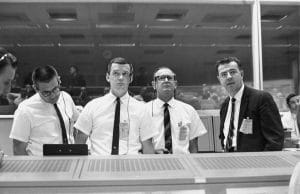Born in the coal mining town of Old Forge, Pa., Lunney’s father, a miner turned welder, told him to get an education so he had a life outside mining. The boy was interested in model airplanes, so when the time came he decided to study engineering at the University of Scranton, and in 1955 transferred to the University of Detroit for a cooperative study program with the Lewis Research Center in Cleveland, Ohio. LRC was established in 1942 and was part of the National Advisory Committee for Aeronautics, and a few years earlier had started working on liquid-fueled rockets. When he graduated in 1958, Lunney went to work at Lewis. A month later, NACA was absorbed by a new agency: NASA. “There was no such thing as space flight until the month I got out of college,” he said later of his timing.

Lunney was then transferred to Langley Research Center in Hampton, Va., and was assigned to the Space Task Group, which was given responsibility for the creation of NASA’s human spaceflight program. At 21, he was the youngest of the 45 members of the group. His first assignment was with the Control Center Simulation Group, which was to create simulations to train both flight controllers and astronauts for spaceflight operations. His team’s job: write the operations plans and mission rules for controllers to follow. During project Mercury, he was the second to be chosen for the role of “Flight Dynamics Officer” to control the trajectories of spacecraft. When it became clear that Mercury Mission Control was way too small for upcoming missions, the Space Task Group was reorganized into the Manned Spacecraft Center at the NASA center in Houston, Texas. Lunney was promoted to be the head of the Mission Logic and Computer Hardware section to create the consoles at the new Mission Control Center. With missions starting to span days instead of hours, Chief Flight Director Christopher Kraft Jr. (Honorary Unsubscribe, 21 July 2019) designated two people to be backups to himself and his deputy, John Hodge, so that someone would be at the position non-stop during missions. He chose Gene Kranz and Glynn Lunney. Of the four controllers, Lunney, at 28, was by far the youngest. He was chosen as the Lead Flight Director for Apollo 7, the first manned Apollo flight.

Lunney was so quick-thinking that another controller said “Glynn would drive you crazy because his mind would race so fast that he could churn out action items quicker than you could absorb, much less answer.” That was a handy attribute when Apollo 13 had their in-flight emergency, where Flight Directors had to figure out how to save the astronauts. During that process Lunney, said astronaut Ken Mattingly, exhibited “the most magnificent display of personal leadership that I’ve ever seen.” Lunney himself said the 14 hours after the Apollo 13 explosion “was the best piece of operations work I ever did or could hope to do. It posed a continuous demand for the best decisions, often without hard data and mostly on the basis of judgment, in the face of the most severe in-flight emergency faced thus far in manned space flight. There might have been a ‘better’ solution, but it still is not apparent what it would be.”
Lunney retired from NASA as the Space Shuttle Program manager in 1985. But he wasn’t done: he went to work with Rockwell International, which was responsible for the orbiters’ construction, operations, and maintenance, and was soon promoted to be president of Rockwell Space Operations. He finally retired for good in 1999. “Glynn was the right person for the right time in history,” declared Johnson Spacecraft Center Director Mark Geyer. “His unique leadership and remarkably quick intellect were critical to the success of some of the most iconic accomplishments in human space flight. While he was one of the most famous NASA alumni, he was also one of the most humble people I have ever worked with.” Lunney was diagnosed with leukemia, and fought it for several years. He died on March 19, at 84.
